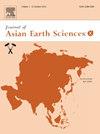Assessing the performance of machine learning and analytical hierarchy process (AHP) models for rainwater harvesting potential zone identification in hilly region, Bangladesh
IF 2.3
Q3 GEOSCIENCES, MULTIDISCIPLINARY
引用次数: 0
Abstract
Water scarcity in hilly regions presents unique challenges, particularly in Bangladesh, where obtaining fresh drinking water has become difficult to access. This study aims to evaluate the potential zones for rainwater harvesting (RWH) using machine learning (ML) algorithms and geospatial analysis. Specifically, four ML algorithms—random forest (RF), boosted regression trees (BRT), k-nearest neighbors (KNN), and naïve bayes (NB)—alongside the analytical hierarchy process (AHP) were employed to delineate potential RWH zones in the Chattogram hilly districts, including Chattogram, Rangamati, Bandarban, Khagrachari, and Cox’s Bazar. Eleven influencing factors were considered: aspect, distance from road, drainage density, elevation, hill shade, lineament density, land use/land cover (LULC), slope, topographic wetness index (TWI), rainfall, and geology. Inventory data from the study area, consisting of 135 suitable and 135 non-suitable points, were randomly split, with 70% used for training the models and the remaining 30% for validation using the area under the curve (AUC) values. The southern regions are highly suitable for harvesting rainwater. Among the five models, BRT and RF demonstrated superior performance with AUC values of 0.93 for both models. In contrast, the AHP method yielded the lowest AUC value at 0.82. Notably, drainage density and elevation emerged as the most influential factors in constructing these models. The application of machine learning algorithms has enhanced the precision of rainwater harvesting zone estimate systems by examining diverse aspects. The findings of this study can provide valuable insights for policymakers in making informed decisions regarding RWH in these regions.

评估机器学习和层次分析法(AHP)模型在孟加拉国丘陵地区雨水收集潜在区识别中的性能
丘陵地区的水资源短缺带来了独特的挑战,特别是在孟加拉国,在那里获得新鲜饮用水变得很难。本研究旨在利用机器学习(ML)算法和地理空间分析来评估雨水收集(RWH)的潜在区域。具体来说,四种机器学习算法——随机森林(RF)、增强回归树(BRT)、k近邻(KNN)和naïve贝叶斯(NB)——与分析层次分析法(AHP)一起,被用来描绘Chattogram丘陵地区的潜在RWH区,包括Chattogram、Rangamati、Bandarban、Khagrachari和Cox 's Bazar。考虑了11个影响因素:坡向、与道路的距离、排水密度、高程、山阴、地形密度、土地利用/土地覆盖(LULC)、坡度、地形湿度指数(TWI)、降雨量和地质。来自研究区域的库存数据由135个合适点和135个不合适点组成,随机分割,其中70%用于训练模型,其余30%用于使用曲线下面积(AUC)值进行验证。南方地区非常适合收集雨水。在5种模型中,BRT和RF模型的AUC值均为0.93,表现出较好的性能。AHP法的AUC值最低,为0.82。值得注意的是,在构建这些模型时,排水密度和海拔是影响最大的因素。机器学习算法的应用从多个方面提高了集雨区估算系统的精度。本研究的发现可以为这些地区的政策制定者做出有关RWH的明智决策提供有价值的见解。
本文章由计算机程序翻译,如有差异,请以英文原文为准。
求助全文
约1分钟内获得全文
求助全文
来源期刊

Journal of Asian Earth Sciences: X
Earth and Planetary Sciences-Earth-Surface Processes
CiteScore
3.40
自引率
0.00%
发文量
53
审稿时长
28 weeks
 求助内容:
求助内容: 应助结果提醒方式:
应助结果提醒方式:


